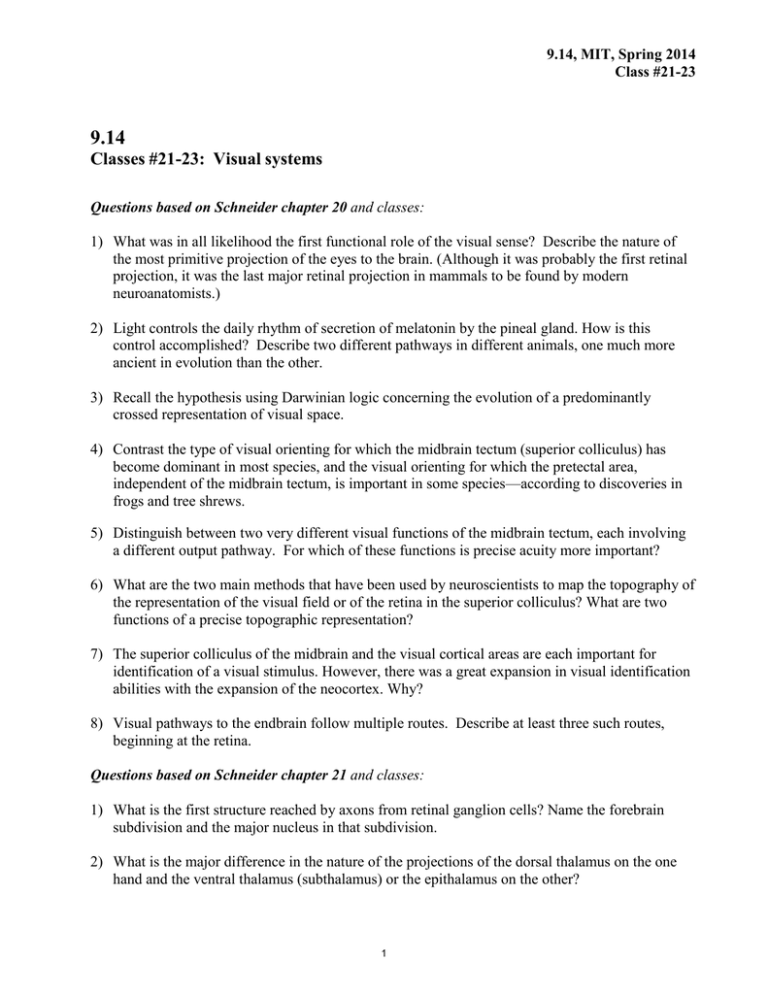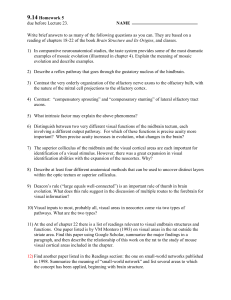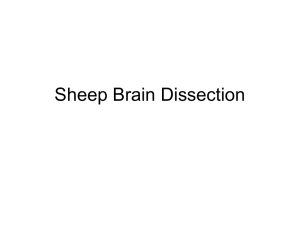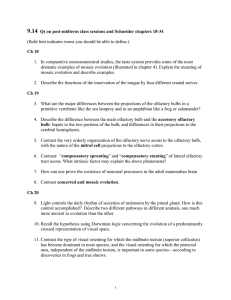9.14 Classes #21-23: Visual systems
advertisement

9.14, MIT, Spring 2014 Class #21-23 9.14 Classes #21-23: Visual systems Questions based on Schneider chapter 20 and classes: 1) What was in all likelihood the first functional role of the visual sense? Describe the nature of the most primitive projection of the eyes to the brain. (Although it was probably the first retinal projection, it was the last major retinal projection in mammals to be found by modern neuroanatomists.) 2) Light controls the daily rhythm of secretion of melatonin by the pineal gland. How is this control accomplished? Describe two different pathways in different animals, one much more ancient in evolution than the other. 3) Recall the hypothesis using Darwinian logic concerning the evolution of a predominantly crossed representation of visual space. 4) Contrast the type of visual orienting for which the midbrain tectum (superior colliculus) has become dominant in most species, and the visual orienting for which the pretectal area, independent of the midbrain tectum, is important in some species—according to discoveries in frogs and tree shrews. 5) Distinguish between two very different visual functions of the midbrain tectum, each involving a different output pathway. For which of these functions is precise acuity more important? 6) What are the two main methods that have been used by neuroscientists to map the topography of the representation of the visual field or of the retina in the superior colliculus? What are two functions of a precise topographic representation? 7) The superior colliculus of the midbrain and the visual cortical areas are each important for identification of a visual stimulus. However, there was a great expansion in visual identification abilities with the expansion of the neocortex. Why? 8) Visual pathways to the endbrain follow multiple routes. Describe at least three such routes, beginning at the retina. Questions based on Schneider chapter 21 and classes: 1) What is the first structure reached by axons from retinal ganglion cells? Name the forebrain subdivision and the major nucleus in that subdivision. 2) What is the major difference in the nature of the projections of the dorsal thalamus on the one hand and the ventral thalamus (subthalamus) or the epithalamus on the other? 1 9.14, MIT, Spring 2014 Class #21-23 3) In this chapter, the epithalamus is described as a caudalmost diencephalic neuromere that includes cell groups where the optic tract has dense terminations. What is this terminal area called? 4) Name the five main optic-tract termination areas in the order they are reached by the optic tract. What additional areas receive sparse retinal projections from the main optic tract? 5) Inputs from the right and left eyes terminate in distinct areas, a separation that is especially important for creating binocular disparity cues to depth of visually perceived objects. Describe the appearance of the distinct areas in the diencephalon of a small rodent and of a monkey. 6) Axons that leave the main optic tract and terminate in small cell groups (up to 3 of them) are described as the optic tract axons. 7) Study figures 21.5, 21.6 and 21.7. Next, cover the labels written above and below the photo of figure 21.7, and see if you can remember the names of structures to which the blue lines are pointed. 8) Do the same for figure 21.8, covering up the names between the two photographs. 9) Which structures can you recognize in figures 21.9 and 21.10? What would make this more difficult during a neurosurgical procedure? 10) Describe at least four different anatomical methods that can be used to uncover distinct layers within the optic tectum or superior colliculus. 11) Name three animals or groups of animals that have a very large optic tectum? (See also chapters 6 and 11.) 12) Why is the term “optic tectum” misleading about this structure? Questions based on Schneider chapter 22 and classes: 1) Deacon’s rule (“large equals well-connected”) is an important rule of thumb in brain evolution. What does this rule suggest in the discussion of multiple routes to the forebrain for visual information? 2) What are the two routes to the endbrain taken by visual information that are usually considered the major ones in present-day mammals, reptiles and birds? 3) What is the most rapid route from retina to endbrain, the route that has become the most dominant of the multiple visual pathways to the endbrain in the primates? 4) Describe one other unimodal pathway taken by visual information to the endbrain that is also probably of major importance in modern mammals although it is less discussed. 2 9.14, MIT, Spring 2014 Class #21-23 5) What visual areas of the neocortex are believed to be the most primitive? 6) What causes the “temporalization” of the cerebral hemispheres? In development and in evolution it is correlated with the expansion of one group of thalamic nuclei. Which nuclei? 7) What are the optic radiations, and what happens to them in animals with relatively large temporal lobes? 8) What are two methods used by neuroscientists to map multiple visual areas in the neocortex? Why is it believed that the human brain contains more visual areas than the 32 described for the rhesus monkey? 9) Why might there be so many visual areas in mammals with large brains? 10) Visual inputs to most, probably all, visual areas in neocortex come via two types of pathways. What are the two types? 11) Contrast the functions of the three transcortical pathways described in chapter 22, from primary visual cortex in primates and probably in other mammals as well. Also describe major anatomical differences in these pathways. Questions on supplementary readings John Allman, Evolving Brains: 1. “The advantages and costs of front-facing eyes”: Give examples of both advantages and costs. How did a cost of front-facing eyes increase the adaptive advantages of social groups? 2. What data on the midbrain indicate that the large bats known as megachiropterans are not “flying primates”? 3. How do areas 17 (striate cortex) and MT stand out from other neocortical areas in stained sections of the brains of primates? 4. What is meant by “classical” and “non-classical” receptive fields of MT neurons? What does the existence of very large non-classical receptive fields imply about connectivity of the neurons? 5. What specialized neocortical areas concerned with vision, beyond the striate area, have been found in humans by functional magnetic resonance imaging? Give two examples. 6. Allman has found neurons unique to the brains of humans and great apes. Where are these neurons? Georg Striedter, Principles of Brain Evolution, ch 5, and also class discussions: 3 9.14, MIT, Spring 2014 Class #21-23 7. Describe an example of “mosaic evolution” in the dorsal midbrain of mammals. 8. Describe two examples of mosaic evolution in the hindbrain of fishes. 9. What is Harry Jerison’s principle of proper mass? When (in what circumstance) does this principle work best? 10. What functional correlate of relative size of the hippocampus has been described for birds? Questions on readings: Striedter ch 6 and lectures 11. Give two examples of lamination in the brain’s visual system or other systems. Why does Striedter use examples of lamination in his discussion of “phylogenetic conversion”? 12. What is meant by “proliferation by phylogenetic segregation” in the dorsal thalamus? 13. Describe how the primate visual cortex has provided a striking example of phylogenetic proliferation by addition. 14. Describe the relationship of neocortical size to number of visual neocortical areas in mammals. 15. Explain what is meant by proportional connectivity, absolute connectivity, and small world architecture. 4 MIT OpenCourseWare http://ocw.mit.edu 9.14 Brain Structure and Its Origins Spring 2014 For information about citing these materials or our Terms of Use, visit: http://ocw.mit.edu/terms.




